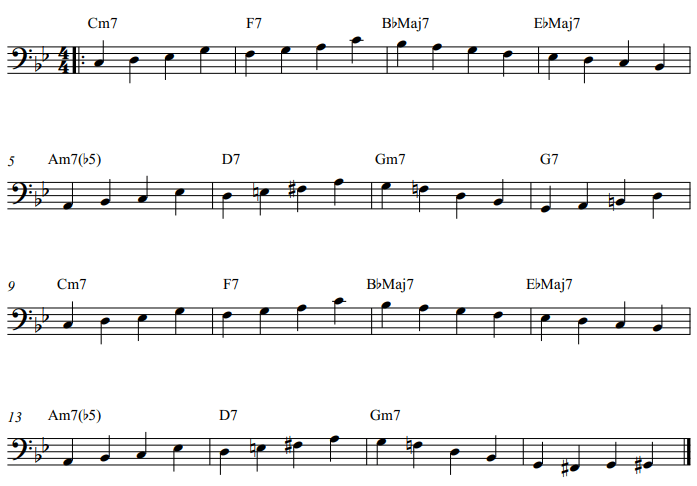If you are interested in finding out how to play walking bass lines on the piano, there is a good chance you are not exactly a piano beginner. Often, you’ll find the lessons on Walking Bass geared around jazz; but you can also use walking bass lines in styles like Rockabilly, Pop, Rock´n´Roll, Boogie Woogie, and so much more. Understanding how and why Walking Bass lines work, and knowing how to play them will greatly increase both the range of songs you can play and your improvisation skills.
The Basics
The bass’ and drums’ job in music is to get a specific vibe of a song – its”groove” – going. That’s why these two instruments are regarded as the “rhythm section”. They take care of a song’s basic “feeling”, while the melody adds musical complexity – mood, colour, and story. Depending on the genre, you will find there are commonly used drum’n’bass patterns. These can be learned.
Chord Construction
The walking bass on the piano basically outlines the chords as they are played. Remember a basic major chord is constructed of the 1st, 3rd, and 5th notes of the scale. If we flatten or raise the third and fifth, we get minor, augmented, diminished, or “sus” chords. And we can heap on more notes to “color” our chords – to create the 6th, 7th, 9th chords, and more.
The Key Principle
Choose notes from the chord as your bass line. If you play a C major chord your bass notes will revolve around C-E-G. When you switch to the next chord, the bass needs to change to the appropriate notes of that chord.
The Walking Bass Basics
Another common feature of the walking bass is the use of syncopated quarter notes (“on the beat”). It is often played in this very simple manner – great news for beginners. Later, as we expand into genres like Rock and Funk, we will spice up our notes up by adding some syncopation and 1/8 notes.
So – let’s start!
One of the easiest bass lines has a simple Boogie-Woogie vibe. Imagine a simple song with the chords C-F-G, then, starting on the second octave of your piano play quarter notes like shown:
… the C chord …
…the F chord, and finish up with…
…the G chord. And then you can end it on C again.
Voila, you have played a walking bass line. Now, to technically turn it into a Boogie-Woogie, play the line above but jump to the next octave. So C to C, E to E, G to G, A to A, and then the next octave C-C. This long stretch of your hand can be difficult so it’s fine to play the simplified version. You may have noticed that with the A in the bassline we are outlining a 6th chord, which is common in boogie woogie. If you play this walking bass line and add some C, F, G 6th, 7th, and 9th chords in with your right hand… you have a basic rock n roll Jerry Lee Lewis song going on.
Walking Bass in Jazz Piano
Many folks who look into walking bass lines are potentially going to play jazz, so you will not see the C-F-G (I-IV-V) progression as much as you will see the common jazz Dm-G-C (ii-V-I). And just like in other genres you will be adding notes to really give it more flavor; it is common to see ii7-V7-Imaj7.
A great example of this is the famous song “Autumn Leaves.”
This song is often used in Jazz bass lessons for beginners as it is a perfect example of the walking bass line and the ii-v-I progression. This progression stays the same, but you notice the keys are changing. The Cm7-F7-Bbmaj is the ii-V-I and then we pivot on the Ebmaj to the relative minor of Bb which is Gm in the next ii-V-I. It’s not as complicated as it may seem at first, and that is what is so great about learning a little theory.
Regardless of the genre, these walking bass lines will mostly be simple quarter notes that outline your chords and progressions. The easy quarter notes are great for practicing your left hand while learning the chords you are playing. Even if your sheet music doesn’t have the chords written above the score you can generally get an idea of what they are by looking at the notes of the walking bass line (the first note of each measure is usually the root).
Popular Examples for Practice
There are special exercises in method books for walking bass lines, and plenty of songs that feature them. If you are advanced, you can tackle the ambitious Autumn Leaves:
- Joseph Kosma – Autumn Leaves (Level 54)
Even if a piece of sheet music may be a little advanced, breaking down the keys and chords is an excellent practice. As you learn a new chord, outline the bass notes in quarter notes, and before you know it you will be doing as much improvising as playing what is written on the sheets!
- Michael Bublè – Moondance (Level 59)
- Queen – Crazy Little Thing Called Love (Level 64)
- Pink Floyd – Money (Level 50)
Here, the walking bass shows a slight variation in the time signature, giving it a unique feel.
Once you have a couple of weeks of practice with left-hand quarter notes you will start to feel more comfortable with bass lines. If you have ever wondered how a great musician seems to be able to play almost any song, it is because they know the chord progressions, riffs, and rhythms for each style of music. And now that you know how to play a walking bass line you have a great idea of how to play Jazz, Boogie-Woogie, Rockabilly, Pop, and Rock.







